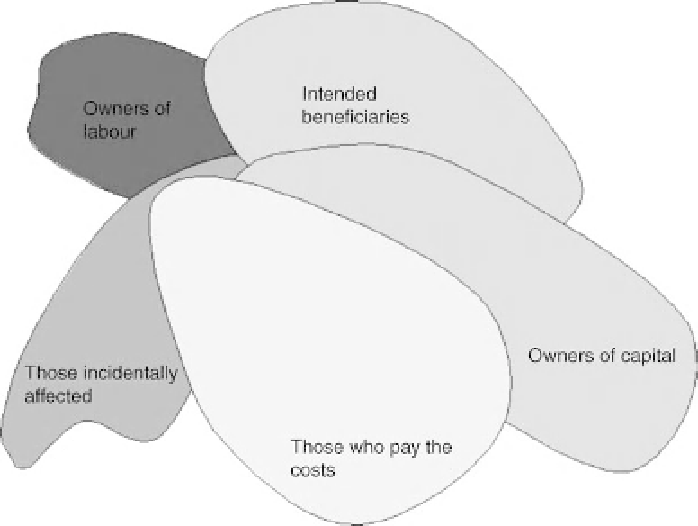Environmental Engineering Reference
In-Depth Information
Fig. 18.1
Who has an interest?
individuals will have more than one interest (e.g.
they pay towards the cost and they are a consumer
of the service provided). Depending on the degree
of overlap between the different sets, the conflicts
of interest are internalized to each individual or
organization in that intersection set or left to be
resolved through collective choice.
So, for example, whilst other people in the
country share a common interest in being a tax-
payer, and so share in the cost of implementing
a river management scheme, some will also visit
the area concerned for recreational or other
purposes, and some will have a concern for the
environmental benefits and costs of the proposed
intervention strategy. Within each of these
groups, there are further subsets with differing
interests; for example, the interests of those who
provide equity capital for a project are not identical
to those who provide loan capital. Different insti-
tutional forms generally result in quite different
patterns of overlap and distribution (Green 2007).
For example, whereas the costs of protecting
against river and coastal flooding are shared across
the UK taxpayers as a whole, the costs of protect-
ing against sewer flooding are wholly borne by
the charge payers of the relevant wastewater
company. Depending upon the degree of overlap
between the different sets, the conflicts of interest
are again internalized to each individual or orga-
nization in that intersection set, or left to be
resolved through collective choice.
In the specific case of flood riskmanagement in
England, Figure 18.2 shows the initial breakdown
of interests. In addition to those at risk of flooding
in a specific area, and the taxpayer who will bear
the costs of any scheme, there are two other key
groups: those at risk elsewhere in the same catch-
ment, and those at risk elsewhere in the country.
The first group has a key interest in that any
scheme in one area may also affect the risk else-
where in the catchment. The interests of thewider
group are affected because given limited resources,
a scheme undertaken in one area will mean that
schemes in other parts of the country and catch-
ment will be delayed or not implemented at all.
Those stakeholders who are engaged either
represent their own personal interest or claim to
represent some wider interest. Traditionally, the
concept of legitimacy (Weber 1947) revolved
around the nation state and was concerned with

